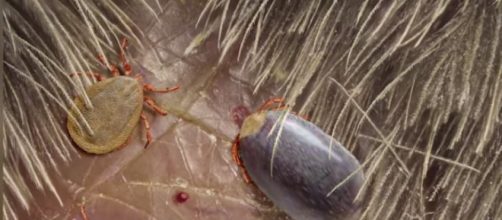In August of 2017, a Hunterdon County New Jersey woman who had been shearing an Icelandic sheep walked into the Health department with samples of an insect she felt crawling on her hand. On closer inspection, her clothing was found to be covered with East Asian ticks in their larval stage.
Furthermore, the March 8, 2018, edition of Business Insider cited that the twelve-year-old Icelandic sheep the woman had been shearing was infested with East Asian ticks in the larval, nymph, and adult stages and covered the animal's ears and face and burrowing under its thick wool.
The emergence of the ticks, which are not native to the United States, has caused some concern among entomologists and New Jersey residents. Spring is approaching which will bring a larger number of people outdoors and will also cause tick populations to increase. The Garden State also has one of the largest numbers of reported Lyme Disease cases in the country.
When officials went to inspect the sheep where it was quarantined, East Asian ticks immediately began attaching themselves to their clothing. Furthermore, investigators counted over one-hundred ticks on the animal itself with another one thousand or so throughout the one-acre paddock.
The sheep's owner gave the animal several chemical permethrin washes to rid it of ticks and when the team returned in November they found no traces of the ticks in either the paddock or on the sheep.
The big question is, had the ticks already attached themselves to other animals like a deer or rabbit and moved out of the immediate area before the sheep become infested? Or were there no further ticks in the area because the cold winter weather killed all of them off?
Invasive species can create havoc on ecosystems
From the kudzu vine and walking catfish to the zebra mussel, Invasive species have caused damage and destruction to the ecosystems they are not native to. The East Asian or Bush tick is a noted invasive species in other areas of the world, as well. There had been isolated reports of the tick in other parts of the country as far back as the 1960's but in smaller numbers.
Invasive species often hitch rides on other animals, by attaching themselves to recreational boats like the zebra mussel, in shipments of fresh fruits and vegetables, inside or outside of shipping containers coming from overseas, and by other means.
There is some speculation that deer and rabbits could possibly have brought the Asian ticks into the western part of New Jersey, while NPR Health cited that one or more ticks could also have hitched a ride into the U.S. on a large animal or even on a person. This particular tick has invaded other parts of the world, as well.
The East Asian tick has the ability to clone itself
The Scientific name of the particular species of East Asian tick that showed up in Herndon County is the Haemaphysalis longicornis, a tick native to East Asia. The species can reproduce asexually, which creates another set of problems, as does the fact that the tick has also been known to carry hemorrhagic diseases.
As quoted by Business Insider, " In rural China, a bite from one East Asian tick can cause an emerging hemorrhagic fever that can be deadly, and also carry diseases like Anaplasma, Ehrlichia, Borrelia, and a form of spotted fever." If a large number of these horned ticks were to attach themselves to one animal, including livestock, they can literally drain the animal of so much blood that it dies from severe blood loss.
The CDC, researchers, tick experts, and other scientists stress diligence in watching out for these and all other species of ticks, especially as winter winds down and the cold is replaced by warmer spring temperatures. By reporting infestations and their locations, the public can assist researchers and entomologists in working on finding ways to control ticks and reduce the numbers of persons infected with tick born diseases of all species.
(For blasting news staff: the photo I selected allows for reuse with attrition given to the photographer which I did."


